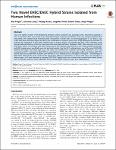Two Novel EHEC/EAEC Hybrid Strains Isolated from Human Infections
Prager, Rita
Lang, Christina
Aurass, Philipp
Fruth, Angelika
Tietze, Erhard
Flieger, Antje
The so far highest number of life-threatening hemolytic uremic syndrome was associated with a food-borne outbreak in 2011 in Germany which was caused by an enterohemorrhagic Escherichia coli (EHEC) of the rare serotype O104:H4. Most importantly, the outbreak strain harbored genes characteristic of both EHEC and enteroaggregative E. coli (EAEC). Such strains have been described seldom but due to the combination of virulence genes show a high pathogenicity potential. To evaluate the importance of EHEC/EAEC hybrid strains in human disease, we analyzed the EHEC strain collection of the German National Reference Centre for Salmonella and other Bacterial Enteric Pathogens (NRC). After exclusion of O104:H4 EHEC/EAEC strains, out of about 2400 EHEC strains sent to NRC between 2008 and 2012, two strains exhibited both EHEC and EAEC marker genes, specifically were stx2 and aatA positive. Like the 2011 outbreak strain, one of the novel EHEC/EAEC harbored the Shiga toxin gene type stx2a. The strain was isolated from a patient with bloody diarrhea in 2010, was serotyped as O59:H−, belonged to MLST ST1136, and exhibited genes for type IV aggregative adherence fimbriae (AAF). The second strain was isolated from a patient with diarrhea in 2012, harbored stx2b, was typed as Orough:H−, and belonged to MLST ST26. Although the strain conferred the aggregative adherence phenotype, no known AAF genes corresponding to fimbrial types I to V were detected. In summary, EHEC/EAEC hybrid strains are currently rarely isolated from human disease cases in Germany and two novel EHEC/EAEC of rare serovars/MLST sequence types were characterized.
Dateien zu dieser Publikation
Keine Lizenzangabe
Verwandte Publikationen
Anzeige der Publikationen mit ähnlichem Titel, Autor, Urheber und Thema.
-
2005-06-20ZeitschriftenartikelViral promoters can initiate expression of toxin genes introduced into Escherichia coli Lewin, Astrid; Mayer, Martin; Chusainow, Janet; Jacob, Daniela; Appel, BerndBackground: The expression of recombinant proteins in eukaryotic cells requires the fusion of the coding region to a promoter functional in the eukaryotic cell line. Viral promoters are very often used for this purpose. ...
-
2014-12-04ZeitschriftenartikelLow Rates of Antimicrobial-Resistant Enterobacteriaceae in Wildlife in Taï National Park, Côte d’Ivoire, Surrounded by Villages with High Prevalence of Multiresistant ESBL-Producing Escherichia coli in People and Domestic Animals Albrechtova, Katerina; Papousek, Ivo; Nys, Helene de; Pauly, Maude; Anoh, Etile; Mossoun, Arsene; Dolejska, Monika; Masarikova, Martina; Metzger, Sonya; Couacy-Hymann, Emmanuel; Akoua-Koffi, Chantal; Wittig, Roman M.; Klimes, Jiri; Cizek, Alois; Leendertz, Fabian; Literak, IvanAntimicrobial resistance genes can be found in all ecosystems, including those where antibiotic selective pressure has never been exerted. We investigated resistance genes in a collection of faecal samples of wildlife ...
-
2010-09-29ZeitschriftenartikelPpiD is a player in the network of periplasmic chaperones in Escherichia coli Matern, Yvonne; Barion, Birgitta; Behrens-Kneip, SusanneBackground: The inner membrane-anchored periplasmic folding factor PpiD is described as a parvulin-like peptidyl prolyl isomerase (PPIase) that assists in the maturation of the major beta-barrel outer membrane proteins ...

